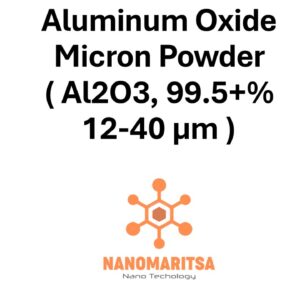Aluminum Oxide Micron Powder (Al₂O₃, 99.5+%, 28–70 µm) is a high-purity alumina powder renowned for its hardness, thermal stability, and chemical resistance. With a particle size range of 28 to 70 micrometers, this powder is particularly suited for applications requiring larger particles with excellent flowability and packing characteristics. Its 99.5+% purity ensures consistent performance, making it ideal for use in advanced ceramics, abrasives, coatings, and high-temperature industrial applications across sectors like aerospace, automotive, and electronics.
1. Key Properties
High Purity (≥99.5%) Minimal impurities guarantee high performance in critical applications, ensuring reliability and consistency in manufacturing processes.
Particle Size (28–70 µm) The coarse particle size supports improved flowability and reduced agglomeration, making it ideal for powder-based manufacturing and coating techniques.
Exceptional Hardness With a hardness near 9 on the Mohs scale, alumina is ideal for wear-resistant applications, including abrasives, grinding tools, and protective coatings.
Thermal Stability With a melting point above 2,000 °C, alumina maintains its mechanical and structural integrity in extreme heat, making it suitable for high-temperature applications.
Chemical Inertness Alumina is highly resistant to most acids, alkalis, and solvents, ensuring durability in corrosive and chemically aggressive environments.
2. Applications
Advanced Ceramics & Refractories Used to produce high-performance ceramics and refractory components, alumina offers exceptional heat resistance and mechanical strength for kiln furniture, nozzles, and industrial equipment.
Abrasives & Polishing The 28–70 µm particle size is ideal for grinding, cutting, and polishing applications, providing efficient material removal and durable wear performance.
Thermal Barrier Coatings Alumina-based coatings protect turbine blades, engine parts, and industrial furnaces from oxidation, thermal cycling, and particle erosion.
Electronics & Insulation Alumina’s dielectric properties and thermal conductivity make it indispensable for substrates, sensor housings, and insulating materials in electronic devices.
Catalysis & Filtration High-purity alumina serves as a catalyst support and filtration medium, withstanding high temperatures and corrosive conditions in petrochemical and environmental systems.
3. Advantages
Improved Flow Characteristics The coarser particle size ensures better flowability, reducing clogs and improving consistency during sintering, spraying, and other powder-based processes.
Wear Resistance Alumina’s exceptional hardness prolongs the lifespan of components, tools, and coatings subjected to abrasive and high-friction environments.
Thermal Endurance Alumina retains its mechanical properties under extreme temperatures, making it ideal for refractory linings, thermal barriers, and high-heat industrial processes.
Chemical Stability Resistance to aggressive chemicals enhances durability in industrial filtration systems, chemical processing, and high-temperature applications.
Electrical Insulation With high dielectric strength and low conductivity, alumina is a trusted material for insulating components in high-voltage and high-temperature electronic systems.
4. Recent Trends and Research
Additive Manufacturing: Efforts are underway to adapt coarse alumina powders for use in 3D printing processes like binder jetting, enabling the production of intricate, durable ceramic parts.
Advanced Coating Techniques: Innovations in plasma spraying, high-velocity oxygen fuel (HVOF), and thermal spray methods are enhancing the durability, adhesion, and uniformity of alumina-based coatings.
Optimized Abrasive Products: Research focuses on improving alumina abrasives for more efficient cutting, grinding, and polishing, targeting both industrial and precision applications.
Sustainable Manufacturing: Recycling alumina from abrasives and ceramic waste is gaining traction, reducing environmental impact and supporting greener production cycles.
Energy Applications: Alumina’s role in catalysis, filtration, and energy storage continues to grow as industries adopt cleaner, more efficient processes.
5. Future Prospects
High-Performance Ceramics: Advances in powder processing and sintering will enable the production of more intricate and high-strength alumina ceramic components.
Innovative Coatings: Alumina-based coatings are expected to play a larger role in aerospace, automotive, and energy systems, protecting components from extreme heat and wear.
Medical & Bioceramic Tools: Alumina’s biocompatibility and wear resistance make it a strong candidate for surgical tools, dental devices, and medical implants.
Lightweight Composites: Alumina-reinforced composites are set to grow in automotive and aerospace applications, offering high strength-to-weight ratios and enhanced durability.
Clean Energy Solutions: Alumina’s applications in catalysis, filtration, and energy storage are expanding, supporting global sustainability initiatives and innovative energy systems.
With its 99.5+% purity and 28–70 µm particle size range, Aluminum Oxide Micron Powder (Al₂O₃, 99.5+%, 28–70 µm) provides outstanding durability, thermal stability, and wear resistance for diverse industrial applications. From advanced ceramics and abrasives to protective coatings and electronics, alumina remains a cornerstone material for cutting-edge manufacturing and engineering.
| Measurement (gr) | 100 grams, 500 grams, 1000 grams |
|---|






